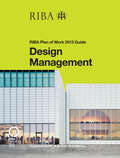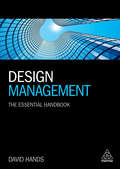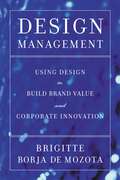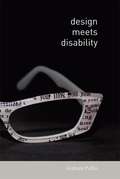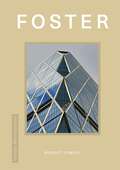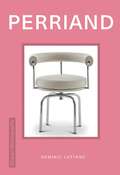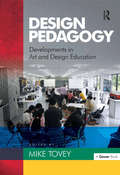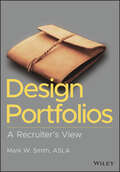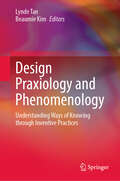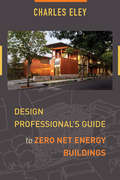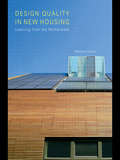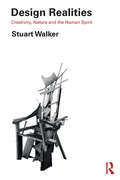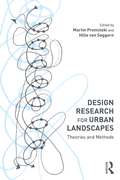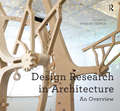- Table View
- List View
Design Management: RIBA Plan of Work 2013 Guide
by Dale SinclairThe RIBA Plan of Work 2013 Guide: Design Management is part of a brand new series providing must-read practical guidance to running efficient and successful projects using the new RIBA Plan of Work 2013. Each guide takes a core project task – in this case the role of the Design Lead - and explains the essential activities and considerations required at each stage of the new Plan of Work. Easy to use and navigate and in a small and handy format these guides will provide the ultimate quick reference support at your desk or on site. The author provides concise and pragmatic advice rooted in real world experience – a ‘how to’ that will resonate with practitioners. In-text features such as ‘hints and tips’, ‘checklists’, ‘forms and templates’ and ‘signposts’ to trusted resources will provide user-friendly support. Boxed examples will highlight best practice and illuminate common problems and solutions borne of hard won experience.
Design Management: The Essential Handbook
by David HandsDesign Management is a discipline in continual motion - changing, responding and adapting to the ever increasing dynamics of social and business transformation. The value of design has grown monumentally since its embryonic stages in the late 1970s, and it now reaches far beyond the realm of industry and commerce, forging a strong presence within the public sector institutions and not-for-profit organisations. Design Management is, quite simply, the essential handbook to all things design. Highly international in its approach, the text is structured around four key perspectives - values, horizons, visions and futures. Each individual section is complemented by input from contributors, with industry leaders and policy makers offering real-world commentary. Ultimately, Design Management represents an important and timely contribution to the discipline of design management itself, and correspondingly the development of product and service innovation. The book argues that design management is a key asset in organisational activity throughout a wide and diverse variety of industrial and geographic contexts within an increasingly globalized world. Engaging and accessible in style, Design Management offers students and practitioners everything they need to know to foster a climate of creative engagement.
Design Management: Using Design to Build Brand Value and Corporate Innovation
by Brigitte Borja De MozotaWritten by a leading authority in the fields of marketing and design, here is first book ever to bring together the theory and practice of design management. In eleven comprehensive chapters, Design Management offers time-tested tools for choosing the right design agency . . . integrating design in the organization . . . creating value and contributing to company performance . . . contributing to brand value and corporate vision . . . and implementing design projects. What's more, dozens of case studies, real-life examples, and leadership profiles illustrate essential theories from design, management, and marketing. An indispensable reference for every design and marketing professional.
Design Materials and Making for Social Change: From Materials We Explore to Materials We Wear (Design Research for Change)
by Rebecca Earley Rosie HornbuckleDesign Materials and Making for Social Change spans the two interconnected worlds of the material and the social, at different scales and in different contexts, and explores the value of the knowledge, skills and methods that emerge when design researchers work directly with materials and hold making central to their practice. Through the social entanglements of addressing material impacts, the contributors to this edited volume examine homelessness, diaspora, migration, the erosion of craft skills and communities, dignity in work and family life, the impacts of colonialism, climate crisis, education, mental health and the shifting complexities in collaborating with and across diverse disciplines and stakeholders. This book celebrates the role of materials and making in design research by demonstrating the diverse and complex interplay between disciplines and the cultures it enables, when in search of alternative futures. Design Materials and Making for Social Change will be of interest to scholars in materials design, textile design, product design, fashion design, maker culture, systemic design, social design, design for sustainability and circular design.
Design Meets Disability
by Graham PullinEyeglasses have been transformed from medical necessity to fashion accessory. This revolution has come about through embracing the design culture of the fashion industry. Why shouldn't design sensibilities also be applied to hearing aids, prosthetic limbs, and communication aids? In return, disability can provoke radical new directions in mainstream design. Charles and Ray Eames's iconic furniture was inspired by a molded plywood leg splint that they designed for injured and disabled servicemen. Designers today could be similarly inspired by disability. In Design Meets Disability, Graham Pullin shows us how design and disability can inspire each other. In the Eameses' work there was a healthy tension between cut-to-the-chase problem solving and more playful explorations. Pullin offers examples of how design can meet disability today. Why, he asks, shouldn't hearing aids be as fashionable as eyewear? What new forms of braille signage might proliferate if designers kept both sighted and visually impaired people in mind? Can simple designs avoid the need for complicated accessibility features? Can such emerging design methods as "experience prototyping" and "critical design" complement clinical trials? Pullin also presents a series of interviews with leading designers about specific disability design projects, including stepstools for people with restricted growth, prosthetic legs (and whether they can be both honest and beautifully designed), and text-to-speech technology with tone of voice. When design meets disability, the diversity of complementary, even contradictory, approaches can enrich each field.
Design Mom: How to Live with Kids: A Room-by-Room Guide
by Gabrielle Stanley BlairNew York Times best seller Ever since Gabrielle Stanley Blair became a parent, she’s believed that a thoughtfully designed home is one of the greatest gifts we can give our families, and that the objects and decor we choose to surround ourselves with tell our family’s story. In this, her first book, Blair offers a room-by-room guide to keeping things sane, organized, creative, and stylish. She provides advice on getting the most out of even the smallest spaces; simple fixes that make it easy for little ones to help out around the house; ingenious storage solutions for the never-ending stream of kid stuff; rainy-day DIY projects; and much, much more.
Design Monograph: Foster
by Robert DimeryA design monograph series on the most remarkable architects, designers, brands and design movements of the twentieth and twenty-first centuries, each book contains a historical-critical essay discussing the life and work of the subject, followed by an illustrated appreciation of groundbreaking work.At 87 Manchester-born Norman Foster has an illustrious career that spans many decades. A titan of design and master of high-tech and sustainable architecture, Foster was instrumental in changing the skyline of London and elevating British design. Among his famous structures are the Gherkin (Swiss Re) and the Millau viaduct bridge.
Design Monograph: Hadid
by Robert DimeryA design monograph series on the most remarkable architects, designers, brands and design movements of the twentieth and twenty-first centuries, each book contains a historical-critical essay discussing the life and work of the subject, followed by an illustrated appreciation of groundbreaking work.One of the few female architects to get world-wide recognition and the first to receive the Pritzker, Iraqi-British Hadid was nicknamed the 'Queen of the Curve'. Dramatic and confident, her buildings were influenced by globalism, elegantly flowing yet full of surprises. Her major works include the London Aquatics Centre for the 2012 Olympics, Broad Art Museum and the Guangzhou Opera House; many others were completed after her unexpected death in 2016.
Design Monograph: Perriand
by Dominic LutyensA design monograph series on the most remarkable architects, designers, brands and design movements of the twentieth and twenty-first centuries, each book contains a historical-critical essay discussing the life and work of the subject, followed by an illustrated appreciation of groundbreaking work.French architect and designer Charlotte Perriand not only created buildings such as the League of Nations in Geneva and ski resorts but was responsible for iconic furniture pieces in tubular steel, such as the Nuage bookshelf, Grand Confort chair (while working for Le Corbusier), B301 recliner and the ponyskin Chaise Longue.
Design Monograph: Perriand
by Dominic LutyensA design monograph series on the most remarkable architects, designers, brands and design movements of the twentieth and twenty-first centuries, each book contains a historical-critical essay discussing the life and work of the subject, followed by an illustrated appreciation of groundbreaking work.French architect and designer Charlotte Perriand not only created buildings such as the League of Nations in Geneva and ski resorts but was responsible for iconic furniture pieces in tubular steel, such as the Nuage bookshelf, Grand Confort chair (while working for Le Corbusier), B301 recliner and the ponyskin Chaise Longue.
Design Monograph: Wright
by Naomi StungoA design monograph series on the most remarkable architects, designers, brands and design movements of the twentieth and twenty-first centuries, each book contains a historical-critical essay discussing the life and work of the subject, followed by an illustrated appreciation of groundbreaking work.The most widely recognized of US architects, Wright designed over 1000 buildings in 70 years. He transformed American architecture and suburban homes with his 'Prairie' style, closely tying his structures into their settings and landscapes in residential designs – most notably in Fallingwater. In this book you will see his both his organic work and his precast concrete forms, as seen in spiral shape of the Guggenheim Museum in New York.
Design Out Crime
by Ian ColquhounHere is a book about the practical design of communities and housing in which people can enjoy a good quality of life, free from crime and fear of crime.Recognising that crime, vandalism and anti-social behaviour are issues of high public concern, and that the driving forces behind crime are numerous, this book argues that good design can help tackle many of these issues. It shows how, through integrating simple crime prevention principles in the design process, it is possible, almost without notice, to make residential environments much safer.Written from the perspective of an architect and town planner, this book offers practical design guidelines through a set of accessible case studies drawn from the UK, USA, The Netherlands and Scandinavia. Each example illustrates how success comes when design solutions reflect local characteristics and where communities are truly sustainable; where residents feel they belong, and where crime is dealt with as part of the bigger picture of urban design.
Design Participation
by Sampsa HyysaloThis open access book Design Participation presents doable and demonstrated ways by which design can become a major contributor to social and environmental change. This entails a shift from seeking to define solutions to opening spaces in which others—activists, entrepreneurs, civil servants, neighborhood communities, politicians (and so on) —can effectively elaborate on and find (re)solutions to the matters they are facing. It is now time to pursue design participation for real: in earnest, skillfully and for real problems. Building on a twenty-year research program, Design Participation shows that participation matters and provides an encompassing resource for understanding the matters of participation: how to think, reflect, plan and work in design participation in different settings and for different issues.
Design Pedagogy: Developments in Art and Design Education
by Mike ToveyDesign Pedagogy explains why it is vital for design students that their education helps them construct a ’passport’ to enter the professional sphere. Recent research into design teaching has focused on its signature pedagogies, those elements which are particularly characteristic of the disciplines. Typically based on core design theory, enlivened by approaches imported to the area, such work has utility when it recognizes the visual language of designing, the media of representation used, and the practical realities of tackling design questions. Increasingly the 21st century sees these activities in a global context where the international language of the visual artefact is recognized. This book draws on recent work in these areas. It includes a number of chapters which are developed from work undertaken during the period of special funding for centres of teaching excellence in the UK up until 2010. Two of those in design have provided the basis for research and innovative developments reported on here. They have helped to enliven the environment for design pedagogy research in other establishments which are also included. Design students need support for the agile navigation through the design process. Learning experiences should develop students’ natural motivations and professionalise motivation to create a resilient, informed and sustainable capacity. This is the essence of ’transformative learning’. This collection explores how design education is, in itself, a passport to practice and showcases how some of the key developments in education use techniques related to collaboration, case studies and experience to motivate students, enable them to express their identity, reflect and learn.
Design Portfolios: A Recruiter's View
by Mark W. SmithUnique perspective of a seasoned designer and veteran A/E industry recruiter regarding what design industry recruiters actually look for in a Design Portfolio Design Portfolios: A Recruiter’s View provides a student-friendly guide, written from the perspective of a designer and design industry recruiter, on what recruiters look for as they review a design portfolio. It shows students how to create a professional-quality portfolio that will get them to that all-important next step in the recruiting process—the interview. Using a unique plan of action, “The Four S’s”, the book presents an organizational mindset focused on the added value of telling your Story, revealing your Style, proclaiming your Substance, and Sharing your uniqueness effectively. In today’s competitive market, a winning portfolio is much more than a simple accounting of digital skills and volumes of high-resolution graphics. This book shows students what recruiters really value and how to ensure their portfolios make the right impression. Design Portfolios: A Recruiter’s View explains: How to develop a memorable organizational approach around story, style, substance, and sharing and create a winning portfolio Answers to the key questions students ask to fill in gaps in their academic instruction Real examples of resumes, cover letters, and portfolios that reveal what is needed for success Years of “big picture” insight gained from actual portfolio reviews during the author’s time as a designer and recruiter Aimed at the inexperienced design student rather than the practicing professional, Design Portfolios: A Recruiter’s View is an easy-to-understand and constructive guide that is incredibly helpful to young designers with project histories that consist only of academic and internship work.
Design Praxiology and Phenomenology: Understanding Ways of Knowing through Inventive Practices
by Beaumie Kim Lynde TanThis book offers insight into designerly ways of knowing from the perspectives of experts and professionals engaging in diverse forms of design in workplaces and other public domains. It also aids in the understanding of design practices from designers’ viewpoints via case studies. By pursuing a reflective inquiry in their design epistemology (designerly ways of knowing), design praxiology (practices of design), or design phenomenology (forms of designs), self-studies of design practices, and presenting studies of designs, the authors of this book demonstrate how they influence the people and the object of inquiry or design. The case studies presented in this book also illustrate how designers develop their expertise, and provides inspiration for the incorporation of design-thinking and practice in education.
Design Principles for Photography
by Jeremy WebbIn an age over-saturated with photographic imagery, Design Principles for Photography demonstrates how design awareness can add a new level of depth to your images. By adapting and experimenting with the tried and tested techniques used by graphic designers every day, you can add dynamism and impact to your imagery, whatever the style or genre - something that today's editors, curators and publishers are all crying out for.The second edition includes examples of unsuccessful compositions, annotated images highlighting key techniques and an expanded glossary. There’s also a new section on movements in photography and their reflection in composition, including modernism, expressionism, and surrealism and interviews with international practitioners discussing how they’ve included design principles in their work. Featured topics: Basic design theory; the use of space; positional decisions; the elements of design; line; shape or form; space; texture; light; colour; pattern; rhythm; contrast; scale and proportion; abstraction; movement and flow; containment; emphasis and emotion; justaposition; incongruity; mood and emotion.
Design Professional's Guide to Zero Net Energy Buildings
by Charles EleyIn the United States, direct energy use in buildings accounts for 39% of carbon dioxide emissions per year--more than any other sector. Buildings contribute to a changing climate and warming of the earth in ways that will significantly affect future generations. Zero net energy (ZNE) buildings are a practical and cost-effective way to reduce our energy needs, employ clean solar and wind technologies, protect the environment, and improve our lives. Interest in ZNE buildings, which produce as much energy as they use over the course of a year, has been growing rapidly.In the Design Professional's Guide to Zero Net Energy Buildings, Charles Eley draws from over 40 years of his own experience, and interviews with other industry experts, to lay out the principles for achieving ZNE buildings and the issues surrounding their development. Eley emphasizes the importance of building energy use in achieving a sustainable future; describes how building energy use can be minimized through smart design and energy efficiency technologies; and presents practical information on how to incorporate renewable energy technologies to meet the lowered energy needs. The book identifies the building types and climates where meeting the goal will be a challenge and offers solutions for these special cases. It shows the reader, through examples and explanations, that these solutions are viable and cost-effective.ZNE buildings are practical and cost-effective ways to address climate change without compromising our quality of life. ZNE buildings are an energizing concept and one that is broadly accepted yet, there is little information on what is required to actually meet these goals. This book shows that the goal is feasible and can be practically achieved in most buildings, that our construction industry is up to the challenge, and that we already have the necessary technologies and knowledge.
Design Quality in New Housing: Learning from the Netherlands
by Matthew CousinsThis book addresses the need for an in-depth study into design quality in new housing. The wider implications of policy and design are examined through a series of case studies of new housing projects in the UK and the Netherlands. Dutch interdisciplinary design and modern methods of construction are widely considered to be of the highest quality from which much can be learned and understood. This new guide offers architects the best practice for the design, policy and construction of new homes. The author considers proposals for the Thames Gateway and government incentives to create better quality housing, including the £60,000 house and design reviews. The wider implications of skills and training of architects, planners, design professionals and those parties involved in housing are also addressed.
Design Readiness for Landscape Architects: Drawing Exercises that Generate Ideas
by Les H. SmithDemands on landscape architecture students’ time are many and varied – when is there a chance to just sketch, and is it worth dedicating your time to the pursuit of drawing? This book shows how in short bursts you can build up your design skills using quick, relaxed sketches, which form the basis for full projects and studio work. This book will provide you with your own image library – sources of inspiration, guidance, and short-cuts to future designs. A variety of paths leading to design discovery, based upon experimental sketching methods, are discussed, demonstrated, and then put into action with valuable exercises. These exercises focus your sketching, giving hints and tips on what to look for, how to capture the essence of the object or location, and how to become a natural in the art of speedy visual communication. Real-life examples of the author’s built-works as a landscape architect show how professionals use these techniques in their own design creations. Design Readiness for Landscape Architects presents enjoyable and thought-stirring essays and drawing-based exercises to help students grow more facile and agile in their service as architects of the land, whether using tablets, paints, or pens and pencils.
Design Realities: Creativity, Nature and the Human Spirit
by Stuart WalkerDesign Realities explores a wide range of topics on creativity, design and spiritual well-being. Using critique, rational inquiry and personal reflection, Stuart Walker looks squarely at our contemporary condition, demonstrates how current assumptions and material expectations are becoming untenable and, most importantly, offers constructive new directions that are feasible, spiritually enriching, and hopeful. Comprising short essays, lyrical pieces, photo studies and longer discourses, this book takes us on a highly readable and enjoyable journey through some of the most pressing issues of our time. The innovative, intuitive format makes these topics readily accessible, while providing much food for thought about the changing nature of creativity in today’s world. Written by a leading thinker in the field, this highly original book offers readers something to ponder, discuss, contest and build upon.
Design Research for Urban Landscapes: Theories and Methods
by Martin Prominski Hille SeggernWithin the spatial design disciplines, research through design as a tool and practice has often been neglected. This book provides a much-needed companion to the theories, methods and processes involved in using design-based research in landscape, architecture and urban design. Aimed specifically at researchers completing PhD projects, supervisors and designers working in practice, it covers applied approaches to help you to use design research in your work. With fully illustrated examples of original international design research PhDs from a variety of programme types, such as individual, structured and practice-based, Design Research for Urban Landscapes offers PhD candidates and supervisors a clear foundational pathway.
Design Research in Architecture: An Overview (Design Research in Architecture)
by Murray FraserWhat is the role of design research in the types of insight and knowledge that architects create? That is the central question raised by this book. It acts as the introductory overview for Ashgate’s major new series, ’Design Research in Architecture’ which has been created in order to establish a firm basis for this emerging field of investigation within architecture. While there have been numerous architects-scholars since the Renaissance who have relied upon the interplay of drawings, models, textual analysis, intellectual ideas and cultural insights to scrutinise the discipline, nonetheless, until recently, there has been a reluctance within architectural culture to acknowledge and accept the role of design research as part of the discourse. However, in many countries around the world, one of the key changes in architecture and architectural education over the last decade has been the acceptance of design as a legitimate research area in its own right and this new series provides a forum where the best proponents of architectural design research can publish their work. This volume provides a broad overview on design research that supports and amplifies the different volumes coming out in the book series. It brings together leading architects and academics to discuss the more general issues involved in design research. At the end, there is an Indicative Bibliography which alludes to a long history of architectural books which can be seen as being in the spirit of design research.
Design Research: Synergies from Interdisciplinary Perspectives
by Jesper SimonsenDesign Research is a new interdisciplinary research area with a social science orientation at its heart, and this book explores how scientific knowledge can be put into practice in ways that are at once ethical, creative, helpful, and extraordinary in their results. In order to clarify the common aspects – in terms of features and approaches – that characterize all strands of research disciplines addressing design, Design Research undertakes an in-depth exploration of the social processes involved in doing design, as well as analyses of the contexts for design use. The book further elicits ‘synergies from interdisciplinary perspectives’ by discussing and elaborating on differing academic perspectives, theoretical backgrounds, and design concept definitions, and evaluating their unique contribution to a general core of design research. This book is an exciting contribution to this little explored field, and offers a truly interdisciplinary approach to the treatment of design and the design process. It is valuable reading for students in disciplines such as design studies and theory, participatory design, informatics, arts based education, planning, sociology, and interdisciplinary programmes in humanities and technology.
Design Resin Jewelry: 37 Beautiful Projects to Make & Wear; For All Skill Levels
by Rozen Martel Nadia JullienCreate gorgeous handmade jewelry Hop on the hottest trend with handcrafted resin jewelry! Resin experts Rozen Martel-Gouélibo and Nadia Jullien share 37 different customizable projects to accessorize any outfit. Never crafted with resin? No worries! A full list of materials, supplies, and how-to instructions are provided for a beginner-friendly experience. Including, the must-know information such as the various types of resins and their uses, how to mold and cast resin, and how to turn your creations into gorgeous pieces of jewelry. Create necklaces, earrings, rings, bracelets, and more, build confidence with the techniques taught, and put your own creative spin on custom jewelry. 37 handcrafted jewelry projects for all skill levels Resin, the thick, glossy topcoat that brings that professional finish to art projects, is versatile and easy to learn and customize Make necklaces, earrings, rings, bracelets, and more with visual step-by-step instructions
